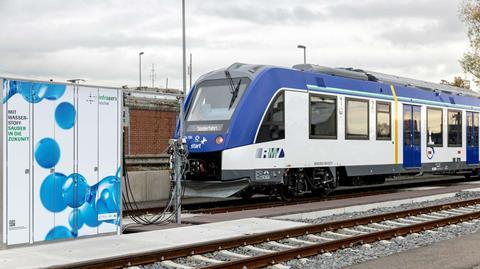
GERMANY: Rhein-Main transport authority RMV has demonstrated the first of 27 Cordia iLint fuel cell multiple-units being delivered by Alstom, which are due to begin entering revenue service from December.
‘Not only are we putting the world’s largest hydrogen train fleet on the rails, we are also replacing diesel-powered trains with hydrogen for the first time in Hessen’, said RMV Managing Director Knut Ringat on November 14.
‘After electric trains, e-buses and hydrogen buses, we are offering our passengers another option for emission-free travel. This is a giant step towards our clear goal: from 2030, our tenders will require vehicles without diesel engines.’
The iLints are intended to operate the Taunus network, which comprises four routes:
- RB11: Bad Soden – Sulzbach – Frankfurt-Höchst (– Kelkheim);
- RB12: Königstein – Kelkheim –Frankfurt-Höchst – Frankfurt Hbf;
- RB15: Brandoberndorf – Usingen (– Friedrichsdorf - Bad Homburg – Frankfurt Hauptbahnhof);
- RB16: Friedberg – Friedrichsdorf – Bad Homburg.
DB subsidiary Regionalverkehre Start Deutschland has been awarded a contract to run these routes for 12 years from December 11, with the initial iLint entering service on RB15.
However, Hessische Landesbahn will temporarily continue running RB11 and RB16 until the end of April, when all of the hydrogen trains are expected to have been delivered.
The hydrogen train project is valued at around €500m over 25 years, including rolling stock procurement, maintenance and operation and the supply of fuel.
RMV’s rolling stock subsidiary Fahma placed the order in May 2019. The units have 160 seats, real-time passenger information, wi-fi and spaces for bicycles, wheelchairs and prams.
They will be maintained by DB Regio in Frankfurt-Griesheim on behalf of Alstom, and fuelled at a filling station built by Infraserv Höchst in the Höchst Industrial Park where the hydrogen is produced.
The federal government is providing €24·3m to support the project, including funding for the fuelling station, and providing up to €14·7 to cover 40% of the additional operating costs over the use of conventional diesel vehicles.
The Land of Hesse has provided €2·5m towards the rail infrastructure for the filling station, as well as €800 000 for preparatory reports and a mobile train refuelling unit.

















